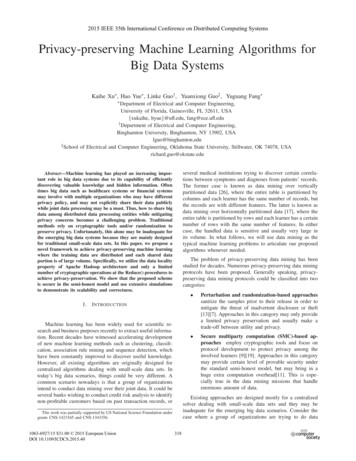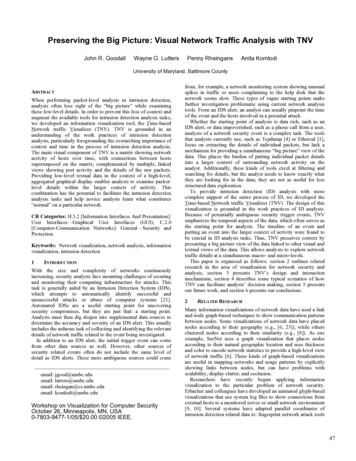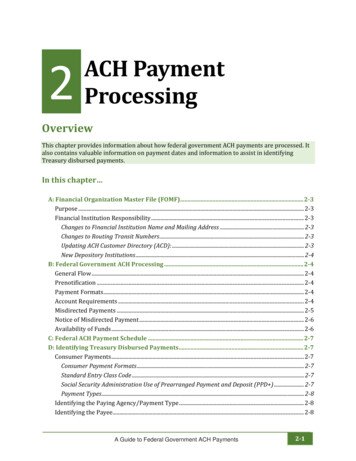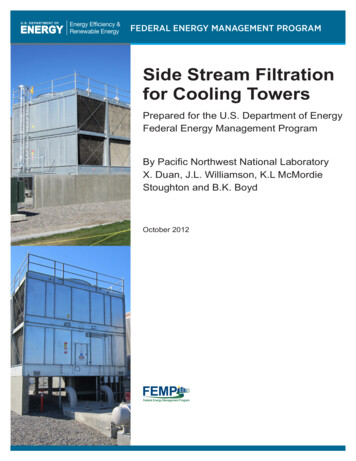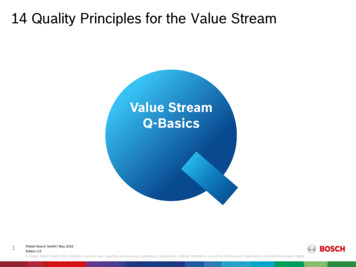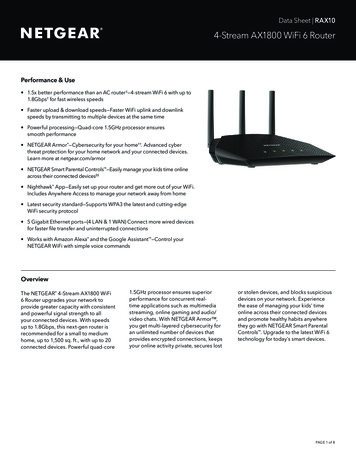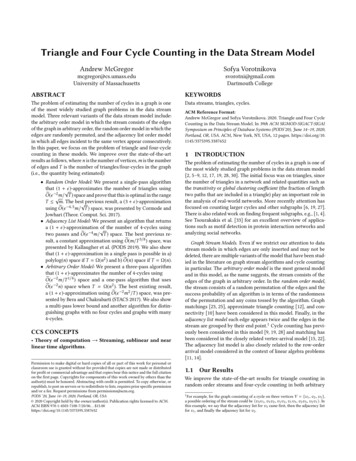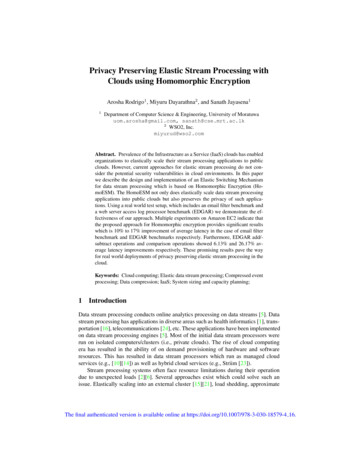
Transcription
Privacy Preserving Elastic Stream Processing withClouds using Homomorphic EncryptionArosha Rodrigo1 , Miyuru Dayarathna2 , and Sanath Jayasena11Department of Computer Science & Engineering, University of Moratuwauom.arosha@gmail.com, sanath@cse.mrt.ac.lk2WSO2, Inc.miyurud@wso2.comAbstract. Prevalence of the Infrastructure as a Service (IaaS) clouds has enabledorganizations to elastically scale their stream processing applications to publicclouds. However, current approaches for elastic stream processing do not consider the potential security vulnerabilities in cloud environments. In this paperwe describe the design and implementation of an Elastic Switching Mechanismfor data stream processing which is based on Homomorphic Encryption (HomoESM). The HomoESM not only does elastically scale data stream processingapplications into public clouds but also preserves the privacy of such applications. Using a real world test setup, which includes an email filter benchmark anda web server access log processor benchmark (EDGAR) we demonstrate the effectiveness of our approach. Multiple experiments on Amazon EC2 indicate thatthe proposed approach for Homomorphic encryption provides significant resultswhich is 10% to 17% improvement of average latency in the case of email filterbenchmark and EDGAR benchmarks respectively. Furthermore, EDGAR add/subtract operations and comparison operations showed 6.13% and 26.17% average latency improvements respectively. These promising results pave the wayfor real world deployments of privacy preserving elastic stream processing in thecloud.Keywords: Cloud computing; Elastic data stream processing; Compressed eventprocessing; Data compression; IaaS; System sizing and capacity planning;1IntroductionData stream processing conducts online analytics processing on data streams [5]. Datastream processing has applications in diverse areas such as health informatics [1], transportation [16], telecommunications [24], etc. These applications have been implementedon data stream processing engines [5]. Most of the initial data stream processors wererun on isolated computers/clusters (i.e., private clouds). The rise of cloud computingera has resulted in the ability of on demand provisioning of hardware and softwareresources. This has resulted in data stream processors which run as managed cloudservices (e.g., [10][14]) as well as hybrid cloud services (e.g., Striim [23]).Stream processing systems often face resource limitations during their operationdue to unexpected loads [2][6]. Several approaches exist which could solve such anissue. Elastically scaling into an external cluster [15][21], load shedding, approximateThe final authenticated version is available online at https://doi.org/10.1007/978-3-030-18579-4 16.
2A. Rodrigo et al.query processing [20], etc. are some examples. Out of these, elastic scaling has becomea key choice because approaches such as load shedding, approximate computing hasto compromise accuracy which is not accepted by certain categories of applications.Previous work has been there which used data compression techniques to optimize thenetwork connection between private and public clouds [21]. However, current elasticscaling mechanisms for stream processing do not consider a very important problem:preserving the privacy of the data sent to public cloud.Preserving the privacy of stream processing operation becomes one of the key questions to be answered when scaling into a public cloud. Sending the data unencryptedto the server definitely exposes them to prying eyes of the eavesdroppers. Sending dataencrypted over the network and decrypting them to get original values at the servermay also expose sensitive information. Multiple work has recently being conductedon privacy preserving data stream mining. Privacy of patient health information hasbeen a serious issue in recent times [19]. Fully Homomorphic Encryption (FHE) hasbeen introduced as a solution [9]. FHE is an advanced encryption technique that allowsdata to be stored and processed in encrypted form. This gives cloud service providersthe opportunity for hosting and processing data without even knowing what the datais. However, current FHE techniques are computationally expensive needing excessivespace for keys and cypher texts. However, it has been shown with some experimentsdone with HElib [12] (an FHE library) that it is practical to implement some basic applications such as streaming sensor data to the cloud and comparing the values to athreshold.In this paper we discuss elastic scaling in a private/public cloud (i.e., hybrid cloud)scenario with privacy preserving data stream processing. We design and implementa privacy preserving Elastic Switching Mechanism (HomoESM) over private/publiccloud system. Homomorphic encryption scheme of HElib has been used on top of thisswitching mechanism for compressing the data sent from private cloud to public cloud.Application logic at the private cloud is implemented with Siddhi event processing engine [16]. We designed and developed two real world data stream processing benchmarks called EmailProcessor and HTTP Log Processor (EDGAR benchmark) duringthe evaluation of the proposed approach. Using multiple experiments on real-worldsystem setup with the stream processing benchmarks we demonstrate the effectivenessof our approach for elastic switching-based privacy preserving stream processing. Weobserve that Homomorphic encryption provides significant results which is 10% to 17%improvement of average latency in the case of Email Filter benchmark. EDGAR comparison and add/subtract operations showed 26.17% average latency improvement. HomoESM is the first known data stream processor which does privacy preserving datastream processing in hybrid cloud scenarios effectively. We have released HomoESMand the benchmark codes as open source software 345 . Specifically, the contributions ofour work can be listed as e-siddhi-server
Elastic Stream Processing with Clouds using Homomorphic Encryption3– Privacy Preserving Elastic Switching Mechanism (HomoESM) - We design anddevelop a mechanism for conducting elastic scaling of stream processing queriesover private/public cloud in a privacy preserving manner.– Benchmarks -We design and develop two benchmarks for evaluating the performance of HomoESM.– Optimization of Homomorphic Operations - We optimized several homomorphicevaluation schemes such as equality, less than/greater than comparison. We also dodata batching based optimizations.– Evaluation - We evaluate the proposed approaches by implementing them on realworld systems.The paper is organized as follows. Next, we provide related work in Section 2. Weprovide the details of system design in Section 3 and implementation of the HomoESMin Section 4. The evaluation details are provided in Section 5. We make a discussion ofthe results in Section 6. We provide the conclusions in Section 7.2Related WorkThere have been multiple previous work on elastic scaling of event processing systemsin cloud environments.Cloud computing allows for realizing an elastic stream computing service, by dynamically adjusting used resources to the current conditions. Hummer et al. discussedhow elastic computing of data streams can be achieved on top of Cloud computing[13]. They mentioned that the most obvious form of elasticity is to scale with the inputdata rate and the complexity of operations (acquiring new resources when needed andreleasing resources when possible). However, most operators in stream computing arestateful and cannot be easily split up or migrated (e.g., window queries need to storethe past sequence of events). In HomoESM we handle this type of queries by queryswitching.Stormy is a system developed to evaluate the “stream processing as service” concept [18]. The idea was to build a distributed stream processing service using techniquesused in cloud data storage systems. Stormy is built with scalability, elasticity and multitenancy in mind to fit in the cloud environment. They have used distributed hash tables(DHT) to build their solution. They have used DHTs to distribute the queries amongmultiple nodes and to route events from one query to another. Stormy builds a publicstreaming service where users can add new streams on demand. One of the main limitations in Stormy is it assumes that a query can be completely executed on one node.Hence, Stormy is unable to deal with streams for which the incoming event rate exceedsthe capacity of a node. This is an issue which we address in our work via the conceptof data switching of HomoESM.Cervino et al. try to solve the problem of providing a resource provisioning mechanism to overcome inherent deficiencies of cloud infrastructure [2]. They have conductedsome experiments on Amazon EC2 to investigate the problems that might affect badlyon a stream processing system. They have come up with an algorithm to scale up/downthe number of VMs (or EC2 instances) based solely on the input stream rate. The goal
4A. Rodrigo et al.is to keep the system with a given latency and throughput for varying loads by adaptively provisioning VMs for streaming system to scale up/down. However, none of theabove-mentioned works have investigated on reducing the amount of data sent to publicclouds in such elastic scheduling scenarios. In this work we address this issue.Data stream compression has been studied in the field of data mining. Cuzzocrea etal. have conducted research on a lossy compression method for efficient OLAP [3] overdata streams. Their compression method exploits semantics of the reference applicationand drives the compression process by means of the “degree of interestingness”. Thegoal of this work was to develop a methodology and required data structures to enablesummarization of the incoming data stream. However, the proposed methodology tradesoff accuracy and precision for the reduced size.Dai et al. have implemented homomorphic encryption library [4] on Graphic Processing Unit (GPU) to accelerate computations in homomorphic level. As GPUs aremore compute-intensive, they show 51 times speedup on homomorphic sorting algorithm when compared to the previous implementation. Although computation wise itgives better speed up, when encrypting a Java String field, its length goes more than400KB which is too large to be sent over a public network. Hence we used HElib as thehomomorphic encryption library in our work.Intel has included a special module in CPU, named Software Guard eXtension(SGX), with its 6th generation Core i5, i7, and Xeon processors [22]. SGX reducesthe trusted computing base(TCB) to a minimal set of trusted code (programmed by theprogrammer) and the SGX processor. Shaon et al. developed a generic framework forsecure data analytics in an untrusted cloud setup with both single user and multi-usersettings [22]. Furthermore, they proposed BigMatrix which is an abstraction for handling large matrix operations in a data oblivious manner to support vectorizations. Theirwork is tailored for data analytics tasks using vectorized computations, and optimalmatrix based operations. However, in this work HomoESM conducts stream processingwhich is different from the batch processing done by BigMatrix.3System DesignIn this section we first describe the architecture of HomoESM and then describe theswitching functions which determine when to start sending data to public cloud.The HomoESM architecture is shown in Figure 1. The components highlighted inthe dark blue color correspond to components which directly implement privacy preserving stream processing functionality.In this system architecture Scheduler collects events from the Plain Event Queueaccording to the configured frequency and the timestamp field on the event. Then itroutes the events into the private publishing thread pool and to the public publishingqueue, according to the load transfer percentage and the threshold values.Receiver receives events from both private & public Siddhi. If the event is from theprivate Siddhi, it is sent to the Profiler. If not the event is a composite event and it isdirected to the ‘Composite Event Decode Worker’ threads located inside the Decryptorwhich basically performs the decryption function. Finally, all the streams which goesout from HomoESM run through Profiler which conducts the latency measurements.
Elastic Stream Processing with Clouds using Homomorphic EncryptionInput eventsstreamQoSSpecification5Portion of the eventsstream directed to publiccloud with erPrivatecloudHElib APIHomomorphicCEP EngineReceiverDecryptorCEP sults streamOutput eventsstreamFig. 1. The system architecture of Homomorphic Encryption based ESM (HomoESM).In this paper we use the same switching functions described in [5] for triggeringand stopping data sending to public cloud (See Equation 1). It should be noted thatthe main contribution of this paper is to describe the elastic privacy preserving streamfunctionality. Here φV M (t) is the binary switching function for a single VM, t is thetime period of interest. Lt 1 and Dt 1 are the latency and data rate values measuredin the previous time period. A time period of τ has to be elapsed in order for the VMstartup process to trigger. Ds is the threshold for total amount of data received by theVM from private cloud.φV M (t) 1, Lt 1 Ls , τ has elapsed. 0, Dt 1 Ds , Lt 1 Lp4,(1)Otherwise,ImplementationIn this Section first we describe the implementation details of HomoESM in Section 4.1and we describe the benchmark implementations in Sections 4.2, 4.3, 4.4, and 4.5.4.1Implementation of HomoESMWe have developed the HomoESM on top of the WSO2 Stream Processor (WSO2 SP)software stack. WSO2 SP is an open source, lightweight, easy-to-use, stream processingengine [26]. WSO2 SP internally uses Siddhi which is a complex event processinglibrary [16]. Siddhi feature of WSO2 SP lets users run queries using an SQL like querylanguage in order to get notifications on interesting real-time events.
6A. Rodrigo et al.High-level view of the system implementation is shown in Figure 2. Input eventsare received by the ‘Event Publisher’. Java objects are created for each incoming eventand put into a queue. Event publisher thread picks those Java objects from the queueaccording to the configured period. Next, it evaluates whether the picked event needsto be sent to the private or the public Siddhi server, according to the configured loadtransfer percentage and threshold values. If that event needs to be sent to private Siddhi,it will mark the time and delegate the event into a thread pool which handles sending toprivate Siddhi. If that event needs to be sent to public Siddhi, it will mark the time andput into the queue which is processed by the Encrypt Master asynchronously.InputSchedulerEncryptMasterPrivate ProfilerOutputCompositeEventDecodeWorkerPublic cloudPublic Siddhi ServerFig. 2. Main components of HomoESM.Encrypt Master thread (see Figure 3 (a)) periodically checks a queue which keepsthe events required to be sent to public cloud. The queue is maintained by the ‘EventPublisher’ (See Figure 4 (a)). If that queue size is greater than or equal to compositeevent size, it will create a list of events equal to the size of composite event size. Next,it delegates the event encryption and composite event creation task to the ‘CompositeEvent Encode Worker’ (see Figure 3 (b)).Composite Event Encode Worker is a thread pool which handles event encryptionsand composite event creations. First, it combines non-operational fields of each plainevents in the list by the pre-defined separator. Then it converts operational fields intobinary form and combines them together. Next, it pads the operational fields with zeros,in order to encrypt using HElib API. Finally, it performs encryption on those operationalfields and puts the newly created composite event into a queue which is processed bythe ‘Encrypted Events Publisher’ thread (See Figure 4 (b)).Firing events into the public VM is done asynchronously. Decision of how manyevents sent to the public Siddhi server was taken according to the percentage we haveconfigured initially. But the public Siddhi server’s publishing flow has max limit of1500 TPS (Tuples Per Second). If the Event Publisher receives more than the max TPS,the events are routed back into the private Siddhi server’s VM.‘Encrypted Events Publisher’ thread periodically checks for encrypted events in theencrypted queue which is put by the ‘Composite Event Encode Worker’ at the end of thecomposite event creation and encryption process (See Figure 3 (b)). First, it combinesnon-operational fields of each plain event in the list by the pre-defined separator. If there
Elastic Stream Processing with Clouds using Homomorphic EncryptionEncrypt MasterComposite Event EncodeWorkerCombine nonoperational fields in theplain event list by thepre-defined separatorIdle and checkfor plaineventsperiodicallyIs plain eventqueue size compositeevent size ?NoCreate a list of plain eventsand dispatch to'Composite-Event-Encode'Worker thread(a)7Convert operationalfields into binary formand combineYesCombined binary formswill be padded withzerosPerform encryption onoperational fieldsusing HElib APIPut encrypted compositeevent into encrypted queuewhich is processed by'Encrypted-Events-Publisher'(b)Fig. 3. Data encryption and the composite event creation process at the private Siddhi server. (a)Encrypt Master thread (b) Composite Event Encode Worker threadare encrypted events, it will pick those at once and send to public Siddhi server. TheEncryptor module batches events into composite events and encrypts each compositemessage using Homomorphic encryption. The encrypted events are sent to the publiccloud where Homomorphic CEP Engine module conducts the evaluation.We encrypt operand(s) and come up with composite operand field(s) in each HEfunction initially, in order to perform HE operations on operational fields in compositeevent. For example, in the case of the Email Filter benchmark, at the HomomorphicCEP engine which supports Homomorphic evaluations, initially it converts the constantoperand into an integer (int) buffer with size 40 with a necessary 0 padding. Then itreplicates the integer buffer 10 times and encrypts using HElib [11]. Finally, the encrypted value and the relevant field in the composite event are used for HElib’s relevant(e.g., comparison, addition, subtraction, division, etc.) operation homomorphically. Theresult is replaced with the relevant field in the composite event and is sent to the Receiver without any decryption.The received encrypted information is decrypted and decomposed to extract therelevant plain events. The latency measurement happens at the end of this flow. ‘EventReceiver’ thread checks if the event received from the Siddhi server is encrypted withHomomorphic encryption. If so it delegates composite event into ‘Composite EventDecode Worker’. If not it will read payload data and calculate the latency (See Figure5 (a)).After receiving a composite event from the Event Receiver the Composite EventDecode Worker handles all decomposition and decryptions of the composite event (SeeFigure 5 (b)). It first splits non-operational fields in the composite event by the predefined separator. Second, it performs decryption on the operational fields using HElibAPI and splits the decrypted fields into fixed-length strings. Then it creates plain eventsusing the splitted fields. Next, it checks each operational fields in the plain event to see
8A. Rodrigo et al.Event PublisherIdle and checkfor eventsperiodicallyEncr
on data stream processing engines [5]. Most of the initial data stream processors were run on isolated computers/clusters (i.e., private clouds). The rise of cloud computing era has resulted in the ability of on demand provisioning of hardware and software resources. This has resulted in data stream processors which run as managed cloud
